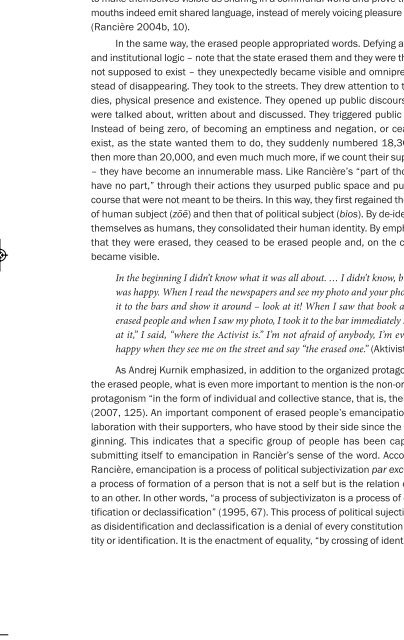The Scars of the Erasure_web
The Scars of the Erasure_web
The Scars of the Erasure_web
- No tags were found...
You also want an ePaper? Increase the reach of your titles
YUMPU automatically turns print PDFs into web optimized ePapers that Google loves.
<strong>Erasure</strong>_4a 10.1.11 20:29 Page 272272 THE SCARS OF THE ERASUREduring <strong>the</strong> time not meant to be <strong>the</strong>irs; for <strong>the</strong>m, nights were meant to be a period<strong>of</strong> rest and preparation for physical work, not intended for contemplation.Or, as Rancière argued, “Politics begins precisely when <strong>the</strong>y who have ‘no time’to do anything else o<strong>the</strong>r than <strong>the</strong>ir work take <strong>the</strong> time that <strong>the</strong>y have not in orderto make <strong>the</strong>mselves visible as sharing in a communal world and prove that <strong>the</strong>irmouths indeed emit shared language, instead <strong>of</strong> merely voicing pleasure or pain”(Rancière 2004b, 10).In <strong>the</strong> same way, <strong>the</strong> erased people appropriated words. Defying any stateand institutional logic – note that <strong>the</strong> state erased <strong>the</strong>m and <strong>the</strong>y were <strong>the</strong>reforenot supposed to exist – <strong>the</strong>y unexpectedly became visible and omnipresent instead<strong>of</strong> disappearing. <strong>The</strong>y took to <strong>the</strong> streets. <strong>The</strong>y drew attention to <strong>the</strong>ir bo -dies, physical presence and existence. <strong>The</strong>y opened up public discourse. <strong>The</strong>ywere talked about, written about and discussed. <strong>The</strong>y triggered public debate.Instead <strong>of</strong> being zero, <strong>of</strong> becoming an emptiness and negation, or ceasing toexist, as <strong>the</strong> state wanted <strong>the</strong>m to do, <strong>the</strong>y suddenly numbered 18,305, and<strong>the</strong>n more than 20,000, and even much much more, if we count <strong>the</strong>ir supporters– <strong>the</strong>y have become an innumerable mass. Like Rancière’s “part <strong>of</strong> those whohave no part,” through <strong>the</strong>ir actions <strong>the</strong>y usurped public space and public discoursethat were not meant to be <strong>the</strong>irs. In this way, <strong>the</strong>y first regained <strong>the</strong> status<strong>of</strong> human subject (zōē) and <strong>the</strong>n that <strong>of</strong> political subject (bios). By de-identifying<strong>the</strong>mselves as humans, <strong>the</strong>y consolidated <strong>the</strong>ir human identity. By emphasizingthat <strong>the</strong>y were erased, <strong>the</strong>y ceased to be erased people and, on <strong>the</strong> contrary,became visible.In <strong>the</strong> beginning I didn’t know what it was all about. … I didn’t know, but <strong>the</strong>n Iwas happy. When I read <strong>the</strong> newspapers and see my photo and your photo I takeit to <strong>the</strong> bars and show it around – look at it! When I saw that book about <strong>the</strong>erased people and when I saw my photo, I took it to <strong>the</strong> bar immediately … “Lookat it,” I said, “where <strong>the</strong> Activist is.” I’m not afraid <strong>of</strong> anybody, I’m even morehappy when <strong>the</strong>y see me on <strong>the</strong> street and say “<strong>the</strong> erased one.” (Aktivist, 45)As Andrej Kurnik emphasized, in addition to <strong>the</strong> organized protagonism <strong>of</strong><strong>the</strong> erased people, what is even more important to mention is <strong>the</strong> non-organizedprotagonism “in <strong>the</strong> form <strong>of</strong> individual and collective stance, that is, <strong>the</strong>ir pride”(2007, 125). An important component <strong>of</strong> erased people’s emancipation is collaborationwith <strong>the</strong>ir supporters, who have stood by <strong>the</strong>ir side since <strong>the</strong> very beginning.This indicates that a specific group <strong>of</strong> people has been capable <strong>of</strong>submitting itself to emancipation in Rancièr’s sense <strong>of</strong> <strong>the</strong> word. According toRancière, emancipation is a process <strong>of</strong> political subjectivization par excellence,a process <strong>of</strong> formation <strong>of</strong> a person that is not a self but is <strong>the</strong> relation <strong>of</strong> a selfto an o<strong>the</strong>r. In o<strong>the</strong>r words, “a process <strong>of</strong> subjectivizaton is a process <strong>of</strong> disidentificationor declassification” (1995, 67). This process <strong>of</strong> political sujectivizationas disidentification and declassification is a denial <strong>of</strong> every constitution <strong>of</strong> identityor identification. It is <strong>the</strong> enactment <strong>of</strong> equality, “by crossing <strong>of</strong> identities, re-


